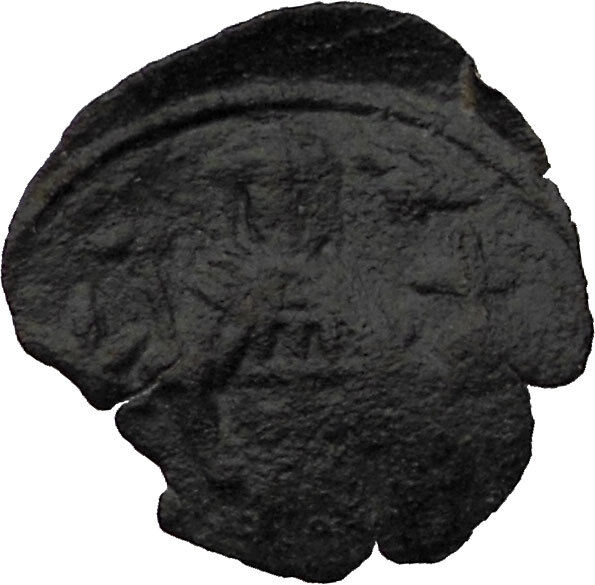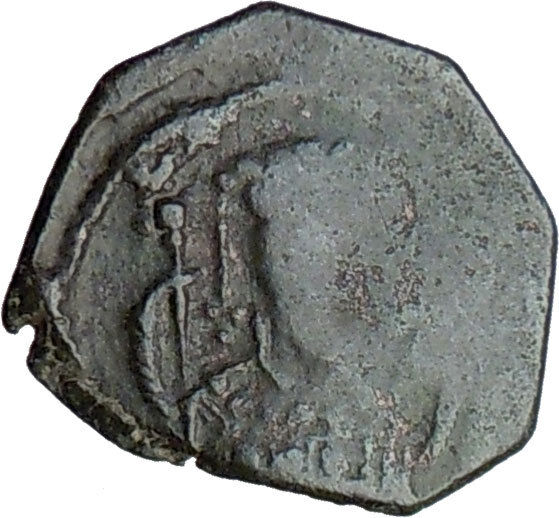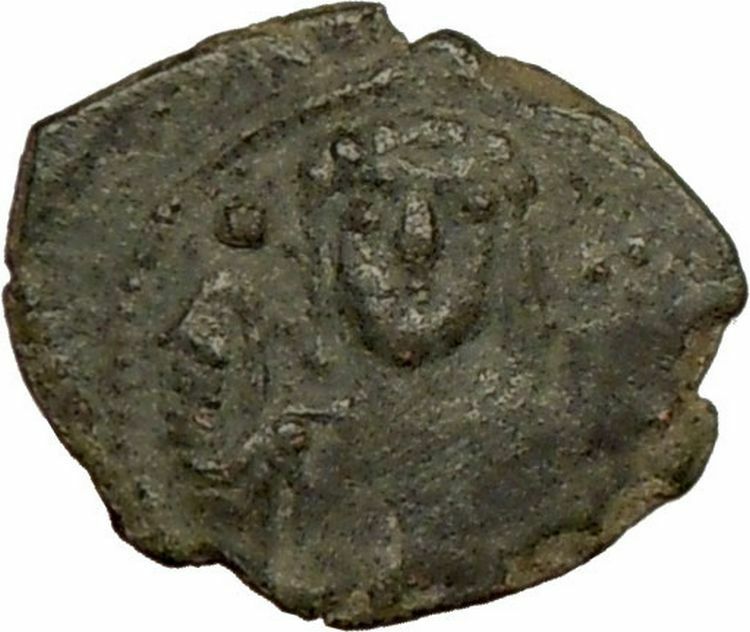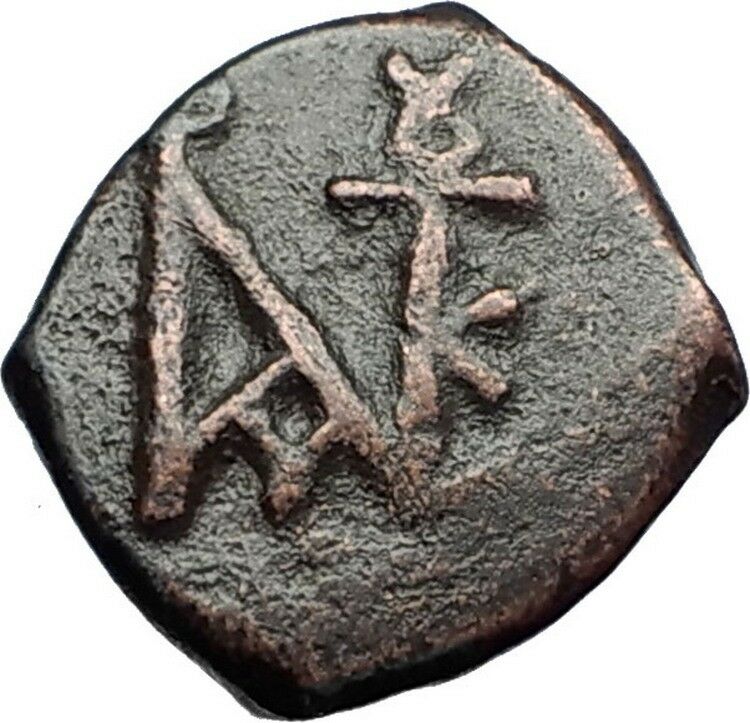|
Byzantine Empire
Justin I – Emperor: July 10, 518 A.D. – August 1, 527 A.D.
Bronze Pentanummium 13mm (1.68 grams) Nicomedia mint, struck circa 518-527 A.D.
Reference: Sear 92; DOC 36; MIBE 46
Diademed, draped and cuirassed bust right.
Large Chi-Rho/Christogram (monogram of Jesus Christ), N-Є across fields.
You are bidding on the exact item pictured, provided with a Certificate of Authenticity and Lifetime Guarantee of Authenticity.
 The Chi Rho is one of the earliest forms of christogram, and is used by some Christians. It is formed by superimposing the first two (capital) letters chi and rho (ΧΡ) of the Greek word “ΧΡΙΣΤΟΣ” = KRistos = Christ in such a way to produce the monogram. Although not technically a Christian cross, the Chi-Rho invokes the authority of Jesus, as well as symbolising his status as the Christ. The Chi Rho is one of the earliest forms of christogram, and is used by some Christians. It is formed by superimposing the first two (capital) letters chi and rho (ΧΡ) of the Greek word “ΧΡΙΣΤΟΣ” = KRistos = Christ in such a way to produce the monogram. Although not technically a Christian cross, the Chi-Rho invokes the authority of Jesus, as well as symbolising his status as the Christ.
The Chi-Rho symbol was also used by pagan Greek scribes to mark, in the margin, a particularly valuable or relevant passage; the combined letters Chi and Rho standing for chrēston, meaning “good.” Some coins of Ptolemy III Euergetes (r. 246-222 BC) were marked with a Chi-Rho.
The Chi-Rho symbol was used by the Roman emperor Constantine I (r. 306-337) as part of a military standard (vexillum), Constantine’s standard was known as the Labarum. Early symbols similar to the Chi Rho were the Staurogram (_I_193_2.jpg/20px-Christliche_Symbolik_(Menzel)_I_193_2.jpg) ) and the IX monogram ( ) and the IX monogram (_I_193_4.jpg/20px-Christliche_Symbolik_(Menzel)_I_193_4.jpg) ). ).
Justin I (Latin: Flavius Iustinus Augustus, Ancient Greek: Ἰουστίνος; 2 February 450 – 1 August 527) was Eastern Roman Emperor from 518 to 527. He rose through the ranks of the army and ultimately became Emperor, in spite of the fact he was illiterate and almost 70 years old at the time of accession. His reign is significant for the founding of the Justinian Dynasty that included his eminent nephew Justinian I and for the enactment of laws that de-emphasized the influence of the old Roman nobility. His consort was Empress Euphemia.
Early career
Justin was a peasant and a swineherd by occupation from the region of Dardania, which is part of the Prefecture of Illyricum. He was born in a hamlet Bederiana near Scupi (modern Skopje, Macedonia). He was of Thraco-Roman or Illyro-Roman stock, spoke only rudimentary Greek, and bore, like his companions and members of his family (Zimarchus, Dityvistus, Boraides, Bigleniza, Sabbatius, etc.), a Thracian name, Istok. His sister Vigilantia (b. ca 455) married Sabbatius and had two children: Petrus Sabbatius Justinianus (b. 483) and Vigilantia (b. ca 490), married to Dulcissimus and had Praejecta (b. ca 520), married to the senator Areobindus and Justin II (b. ca 520).
As a teenager, he and two companions fled from a barbaric invasion, taking refuge in Constantinople possessing nothing more than the ragged clothes on their backs and a sack of bread between them. Justin soon joined the army and, because of his ability, rose through the ranks to become a general under the Emperor Anastasius I; by the time of Anastasius’ death in 518, he held the influential position of comes excubitorum, commander of the palace guard.
Emperor
Thanks to his position commanding the only troops in the city and making gifts of money, Justin was able to secure election as emperor in 518.
A career soldier with little knowledge of statecraft, Justin wisely surrounded himself with trusted advisors. The most prominent of these, of course, was his nephew Flavius Petrus Sabbatius, whom he adopted as his son and invested with the name Iustinianus (Justinian).
Justin’s reign is noteworthy for the resolution of the Acacian Schism between the eastern and western branches of the Christian church. Justin endorsed Rome’s view on the question of the dual nature of Christ and the more general principle of Roman supremacy. This temporary eastern deferral to the western church did not endure.
Relying upon the accounts of the historian Procopius, it often has been said that Justinian ruled the Empire in his uncle’s name during the reign of Justin; however, there is much evidence to the contrary. The information from the Secret History of Procopius was published posthumously. Critics of Procopius (whose work reveals a man seriously disillusioned with his rulers) have dismissed his work as a severely biased source, being vitriolic and pornographic, but without other sources, critics have been unable to discredit some of the assertions in the publication. However, contrary to the Secret History, Justinian was not named as successor until less than a year before Justin’s death and he spent 3,700 pounds of gold during a celebration in 520.
In 525, Justin repealed a law that effectively prohibited a member of the senatorial class from marrying women from a lower class of society, including the theatre, which was considered scandalous at the time. This edict paved the way for Justinian to marry Theodora, a former mime actress, and eventually resulted in a major change to the old class distinctions at the Imperial court. She became an equal to Justinian, participating in the governance with significant influence.
Later years
The latter years of the reign of Justin were marked by strife among the Empire, the Ostrogoths, and the Persians. In 526, Antioch was destroyed by an earthquake, Justin’s health began to decline and he formally named Justinian as co-emperor and, on 1 April 527 as his successor. On 1 August of that year, Justin died and was succeeded by Justinian.
|





 The Chi Rho is one of the earliest forms of christogram, and is used by some Christians. It is formed by superimposing the first two (capital) letters chi and rho (ΧΡ) of the Greek word “ΧΡΙΣΤΟΣ” = KRistos = Christ in such a way to produce the monogram. Although not technically a Christian cross, the Chi-Rho invokes the authority of Jesus, as well as symbolising his status as the Christ.
The Chi Rho is one of the earliest forms of christogram, and is used by some Christians. It is formed by superimposing the first two (capital) letters chi and rho (ΧΡ) of the Greek word “ΧΡΙΣΤΟΣ” = KRistos = Christ in such a way to produce the monogram. Although not technically a Christian cross, the Chi-Rho invokes the authority of Jesus, as well as symbolising his status as the Christ. _I_193_2.jpg/20px-Christliche_Symbolik_(Menzel)_I_193_2.jpg) ) and the IX monogram (
) and the IX monogram (_I_193_4.jpg/20px-Christliche_Symbolik_(Menzel)_I_193_4.jpg) ).
).




